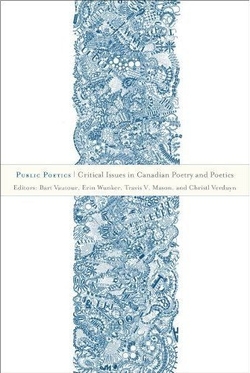
This is a fascinating collection on poetics, although not necessarily because of the work of the editors, and not because many of the essays address poetics – the theory of how most effectively and conscientiously to create poetry. Should one create it to impress, to attract empathy, to amaze, to enable listeners/readers to make new connections, to shock? Should one create it craftily, spontaneously, procedurally, passionately, or in a less-than-rational state as in Fred Wah’s “drunk” poems? Is a poet someone who thinks more deeply and laterally than others, who feels more deeply, who is more nimble with words, who takes more risks with language, who thinks more disjunctively, who sees the multiplicities of meaning in language more readily than others? Are poetics culture specific? Should a poet even think about poetics? – 50-some years ago I received several letters from would-be poets deploring that I took time to ponder poetics issues. Are some forms of language more or less suitable for poetry than others? “Go in fear of abstractions,” Pound once famously advised. Reject closure, suggests Lyn Hejinian. Was Ginsberg right that the first thought for a poem is the best thought? Can language itself suggest the phonic direction of a poem, as Robert Duncan believed? Is simile the bird that comes down too quickly, as Olson declared? Readers won’t find much discussion of such questions here, though they will find what co-editors Bart Vautour and Christl Verduyn term a “contemporary mash-up” (333) of impressions of what poetics might be.
Some of the contributors don't seem much interested in poetics, or perhaps confuse it with thematics and audiences. Every poet employs a poetics – an assumption about what poetry is,
 RSS Feed
RSS Feed